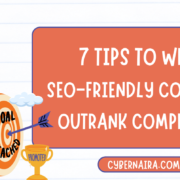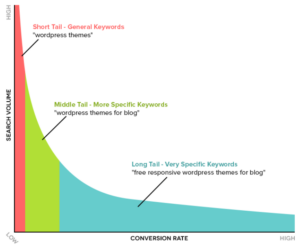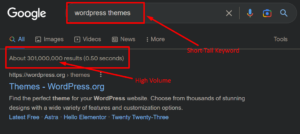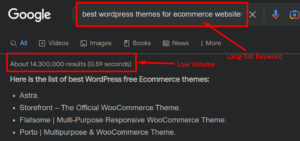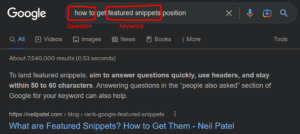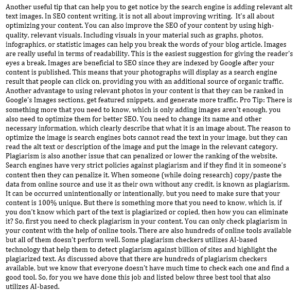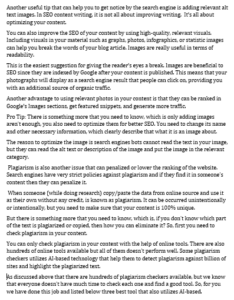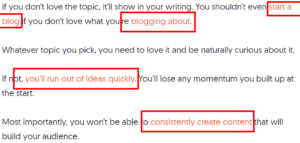7 Tips for Writing SEO-Friendly Content to Outrank your Competitors
7 tips for writing SEO-Friendly content to outrank your competitors: We all know that search engines like Google change their ranking updates yearly. As a result, a lot of websites get a ranking hit. Everything can be changed or replaced, but content and SEO will still remain hand-in-hand, and due to this, they are the most important factors that can raise or lower your website ranking.
If your website is not getting a good ranking on the SERPs, then there might be chances that your website is not according to the guidelines. So, if you want to get a high ranking on the search engine result pages (SERPs), then you have to start writing SEO-friendly content. It isn’t easy to write SEO-friendly content because there are many tips that you need to follow. In this blog, we’ll discuss the seven best tips you can follow to write SEO-friendly content, which will help you rank on the SERPs. So, here are 7 tips to write SEO-Friendly content to outrank competitors.
Table of Contents
1. Use Appropriate Keywords in Your Content
Keywords are one of the most important aspects of SEO. Even though search engines update their algorithms regularly, keywords still remain integral for ranking high.
There are two types of keywords, i.e., short-tail and long-tail keywords. Short-tail keywords contain only one or two words, and they have a higher search volume but a low conversion rate.
On the other hand, long-tail keywords contain more than two words, and they have lower search volume as compared to short-tail keywords but have a high conversion rate.
To make your content SEO-friendly, you need to add appropriate keywords in your content so that search engines can put you on the top when users search for those keywords. Also, you need to use relevant keywords in your content. If you use irrelevant keywords in your content, then the search engine will tag it as “Keyword Stuffing,” which may lead to low ranking on the SERPs.
Try to add relevant keywords at the appropriate place. Also, make sure to use one keyword at least four times in 1,000 words.
This is how you’ll be able to write SEO-friendly content that will rank on the search engine.
2. Optimize Your Content for Feature Snippets
Feature snippet is also a great feature of Google that was introduced in 2014. It is the type of a snippet of text that appears at the top of the Google search results in order to answer the user query quickly. It is automatically pulled from the web page and featured on the top of the search engine.
The most important thing about this feature is you don’t have to get to be in the first position; you just need to optimize your content in the form of questions and answer them.
To optimize the content for feature snippets, you need to add or use questions like how to/where/why/what/when/which, etc., with the right keyword.
Feature snippets also come in the form of lists, bullet points, and step-by-step instructions.
Pro Tip: If you want to get more traffic on your website, then don’t provide the full answer to the user query while writing or optimizing the featured snippet. If you provide the full information, then the user will not come to your site because they get what they are looking for.
This is how you can make your content SEO-friendly and optimize it for better ranking.
3. Optimize the Length of Your Content
The old search engine (Google) ranking algorithms have explained that the longer the content, the higher you rank- however, this no longer matters.
Google has demonstrated over the years that it prioritizes not only lengthier but also higher-quality content. They aim to deliver the best possible answers to their user’s queries.
As a result, publishing long articles that are pointless and have no legitimate intent might well be labelled as “Junk Content” by the search engine.
To optimize the length of your content and make it SEO-friendly, you need to remove unnecessary or repeated words and sentences that are coming again and again. This type of repetition disturbs the content flow. However, you must ensure that the main point of your article is not disrupted.
If you don’t have proper knowledge about how you can shorten the content length without spoiling the quality, then you can also use online summarizing tools.
There are hundreds of tools available online that are used to optimize the length of content. It might be difficult and time-consuming if you try every tool and see which one is better. So, here are some of the decent-working summarizers that can help you in optimizing your content length:
4. Make Sure Your Content is Plagiarism-free
Plagiarism is also another issue that can penalize or lower the ranking of the website. Search engines have very strict policies against plagiarism, and if they find it in someone’s content, then they can penalize it.
When someone (while doing research) copies/paste the data from an online source and use it as their own without any credit, it is known as plagiarism. It can occur unintentionally or intentionally. Regardless of whether it was your intention to plagiarize or not, you need to make sure that your content is 100% unique.
But, if you don’t know or remember which part of the text is plagiarized or copied, then how can you eliminate it?
So, first, you need to check for plagiarism in your content. You can only check plagiarism in your content with the help of online tools. But, like is the case with summarizing tools, there are also a lot of plagiarism checkers on the internet, only a few of which are worth using.
These plagiarism checkers utilize AI-based technology that helps them to detect plagiarism against billion of sites and highlight the plagiarized text.
As discussed above, there are hundreds of plagiarism checkers available, but we know that everyone doesn’t have much time to check each one and find a good tool. So, for you, we have done this job and listed below the three tools that also utilize AI-based algorithms.
You can choose any one of them and check for plagiarism in your content.
So, after you are done checking plagiarism in your content, if it contains more than 10% plagiarism, then make sure to eliminate it. You can also eliminate it by paraphrasing (we are going to discuss it in the next heading).
This is how you will find plagiarism in your content and eliminate it to make it unique, which will boost your content SEO and outrank your competitors.
5. Focus on Content Readability
When it comes to writing for your audience, readability matters the most. Search engines also appreciate content that is well-optimized, readable, and engaging. Readability is the ease with which a reader can easily understand the written text.
Now, let’s think about it…if your content can be easily understood by the reader and provides all the crucial information, then why do search engines will not rank it? Of course they would.
In the above image, every reader will face difficulty in reading this piece of content.
To make your content readable, you need to follow some steps:
- Don’t use complicated words; instead of them, use easy and appropriate synonyms.
- Don’t use lengthy sentences; try to break them into two or more pieces, and each one should contain less than 20 words.
- Don’t write your content in the walls of text (lengthy paragraphs) format. The optimal length of each paragraph is 3-4 lines, don’t exceed it.
- Don’t use too many passive voice sentences; try to change them to active voice.
In the above-given image, the content is in a readable style, and the reader will easily understand it.
If you take the steps mentioned above, and you still find that the content is not readable, you can try taking help from online tools instead. For this purpose, paraphrasing tools can be suitable.
Paraphrasing tools are designed to change the words in the content with synonyms and to alter the sentence structures. AI tools are also equipped with the necessary algorithms that allow them to find out the hard parts in the input so that they can change those parts in order to make them easier to read.
Here is what this normally looks like:
There are also a large number of tools available on the internet, but finding a good one in this large amount is difficult.
Here are some tools that paraphrase the content effectively according to our experience:
By the way, the tool that we used in the above image was Paraphraser.io.
Each above-mentioned tool utilizes AI-based technology, and you can change specific paraphrased words or sentences with their appropriate synonyms in the output box.
With the help of paraphrasing, you will be able to make your content readable and also make it plagiarism-free. And this is how you will optimize your content for search engines and outrank your competitors.
6. Add Visuals to Make Your Content SEO-Friendly
Another useful tip that can help you to get high ranking position on the search engine is adding relevant images.
SEO content writing is not all about improving writing. It’s all about optimizing your content. You can also improve the SEO-friendliness of your content by using high-quality, relevant visuals.
Including visuals in your material can help you break the words of your blog article. Images are really useful in terms of readability. This is the easiest suggestion for giving the reader’s eyes a break.
Images are beneficial to SEO since they are indexed by Google after your content is published. This means that they (the images) will display as a search engine result that people can click on, providing you with an additional source of organic traffic.
Another advantage to using relevant photos in your content is that they can be ranked in Google’s Images sections, get featured snippets, and generate more traffic.
Pro Tip: There is something more that you need to know, which is only adding images isn’t enough. You also need to optimize them for better SEO. You need to change their name and other necessary information, which clearly describes what it is an image about. The reason to optimize the image is that search engines cannot read the text in your image, but they can read the alt text or description of the image and put the image in the relevant category.
So, adding relevant and optimized images can also better your website’s SEO, and you can outrank your competitors.
7. Add Relevant (Inbound or Outbound) Links
It is the most effective tip to boost the SEO of your content. Linking to the relevant site, whether it is outbound or inbound, will improve your visability.
Adding links to relevant pages on your website can better your organic traffic. If you include valuable information on your website, it may encourage visitors to visit it frequently.
Publishing relevant content will make the user stay on your website for more time, which will lower the bounce rate and improve the dwell time. If a search engine notices that your organic traffic stays for more time, then it will rank your site higher.
Along with this, you need to include links to high-authority websites in order to get recognized by readers. This can help you in increasing traffic and conversions.
This is how you’ll be able to boost your content SEO, and it will outrank your competitors.
Continue Reading: SEO Copywriting Guide: Effective Strategies to Enhance Your Content
How to Outrank your Competitors
To make your content SEO-friendly, you need to ensure that there is no plagiarism in it. If plagiarism is found in your content, then make sure to eliminate it.
Along with this, make sure that your content is readable, which a reader can easily understand.
Try to add some visuals like relevant images, graphs, or stats. It improves content and ranks it higher.
Following all the above-mentioned tips will help you to make your content more SEO-friendly, and you will outrank competitors.

